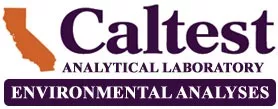FAQ – Frequently Asked Questions
Can you tell me what’s in my water?
Caltest cannot tell you what’s in your water. We can only test your water for a finite list of parameters. Refer to our Homeowner Package page for a list of common well water analyses. https://caltestlabs.com/analytical-services/regulated-drinking-water-homeowners/homeownerspackagesnonregulatory/
How do I get my water tested?
Once you’ve decided what test(s) you want, you must pickup the appropriate sample container(s) at our laboratory. Once the sample is collected, return the sample to laboratory the same day.
Where is Caltest located?
1885 North Kelly Road, Napa CA 94558. 6.6 miles south of downtown Napa. 15 miles from Sonoma. Directions
When can I come to Caltest to pickup containers?
Monday-Friday, except holidays, 8am – 5pm.
What type of bottle do I need?
The type of bottle is dependent of the type of analysis performed. Coliform requires a sterile container that is supplied by the lab. Refer to our bottle reference chart.
Is my water safe to drink?
Caltest does not make evaluations or recommendations regarding results. Please visit www.epa.gov/safewater for more information about drinking water standards. Other useful links can be found on our links page: https://www.caltestlabs.com/downloads/
How do I disinfect my well?
If sample results indicate the presence of coliform bacteria, the following decontamination procedures have been recommended by County Environmental Health Departments:
- If water is cloudy, pump the well until the water appears to be clear.
- Mix one gallon of household bleach, containing 5.25% sodium hypochlorite, to three gallons of water. Greater amounts or stronger chlorine solutions should be used for wells more than 100 feet deep.
- Pour the chlorine solution into the well. It may be necessary to lift the pump out, but some wells have openings that can be used for this purpose.
- Do not operate the pump for 30 minutes. After the 30-minute period, with the taps, faucets and hydrants open or closed, surge the well by starting and stopping the pump several times.
- After surging the well open every tap, faucet or hydrant in the water piping system. Start the pump and let the water flow until clean water with a strong chlorine odor comes out. Stop the pump.
- Close all taps, faucets and hydrants. DO NOT OPERATE FOR 24 HOURS.
- After 24 hours open all outside taps, faucets and hydrants and let the water flow until the chlorine odor is gone. Be careful not to discharge heavily chlorinated water into an individual sewage disposal system.
- A water sample for bacteriological analysis should be obtained one week or more after disinfecting the well.
NOTE: Make sure that your well is tightly sealed to keep out rodents, insects, dirt and surface water seepage. For storage tanks, use 4 ounces of household bleach per 1000 gallons of stored water. This should provide 5ppm of free residual chlorine.
For additional information contact your local County Health Department.
What do the units on my report mean?
The most common units on our reports are mg/L, which is a milligram per liter of water, and ug/L, which is microgram per liter of water. One mg/L is the same as one part per million (ppm) and one ug/L is the same as one part per billion (ppb).
What does “RL” on my report mean?
RL stands for Reporting Limit. This represents how low we are able to detect an analyte in your sample. RL does not represent a recommended or regulatory limit.
What does “ND” on my report mean?
ND stands for Non Detect. That means the analyte was not found in the sample at or above the listed Reporting Limit (RL).
How long does it take to get my water analyzed?
Presence/Absence (P/A) bacteriological tests are completed and mailed within 5 business days from sample receipt. Quantitative bacteriological and chemistry analyses (i.e. Homeowners 2 and 3 packages, Irrigation packages, etc) are completed and mailed within 15 working days. Our standard turnaround time is 10-15 working days.
